Jun 23, 2017 | Market News
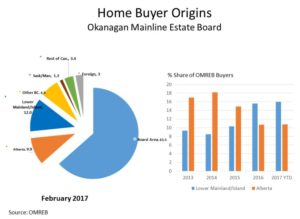 The Thompson-Okanagan region is served by the Okanagan Mainline and South Okanagan Real Estate Boards, as well as the Kamloops & District Real Estate Association. Strong economic conditions in the region are consistent with overall provincial economic performance. The urban centres of Kamloops and Kelowna have increasingly diversified economies that support population growth, rising employment levels and new construction activity.
The Thompson-Okanagan region is served by the Okanagan Mainline and South Okanagan Real Estate Boards, as well as the Kamloops & District Real Estate Association. Strong economic conditions in the region are consistent with overall provincial economic performance. The urban centres of Kamloops and Kelowna have increasingly diversified economies that support population growth, rising employment levels and new construction activity.
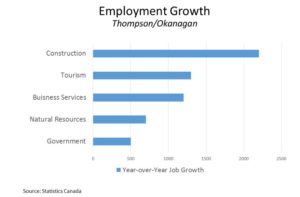 Employment growth in business services, construction and tourism has been particularly robust. While a favourable exchange rate benefits BC exporters, it is also causing an increase in tourism-related activities from international visitors and from Canadians choosing to spend their vacation dollars at home.
Employment growth in business services, construction and tourism has been particularly robust. While a favourable exchange rate benefits BC exporters, it is also causing an increase in tourism-related activities from international visitors and from Canadians choosing to spend their vacation dollars at home.
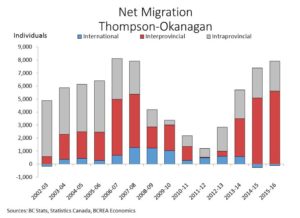 Net migration to the region has returned as a key population growth component after a significant decline in the post-recession period. Both migration from other provinces and from within British Columbia are bolstering the region’s population and adding to housing demand. While the proportion of home-buyers in the Okanagan Mainline Real Estate Board area originating from Alberta has declined since 2014, there has been an offsetting increase in activity origination from Metro Vancouver. The Thompson-Okanagan region’s relative affordability, employment opportunities and retirement lifestyle are significant drivers of migration and overall population growth.
Net migration to the region has returned as a key population growth component after a significant decline in the post-recession period. Both migration from other provinces and from within British Columbia are bolstering the region’s population and adding to housing demand. While the proportion of home-buyers in the Okanagan Mainline Real Estate Board area originating from Alberta has declined since 2014, there has been an offsetting increase in activity origination from Metro Vancouver. The Thompson-Okanagan region’s relative affordability, employment opportunities and retirement lifestyle are significant drivers of migration and overall population growth.
MLS® residential sales through the Okanagan Mainline Real Estate Board have eased from the record level recorded a year ago. However, consumer demand remains at an elevated level, and home sales are expected to post the second best performance on record this year. In the South Okanagan, housing demand is on pace to match last year’s record level, with 2,450 units sold. Meanwhile, housing demand in the Kamloops area is also expected to remain robust this year, with 3,150 units trading hands. Condominiums have been in high demand across the Thompson-Okanagan region this year. Consumer demand for apartments is expected to rise nearly 26% in the South Okanagan and 8% in the Okanagan Mainline areas.
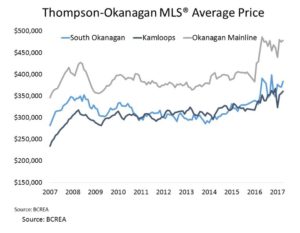 Market conditions in the region have continued to tighten this year. Strong consumer demand has drawn down the inventory of homes for sale and created more intense competition among home-buyers. Total active listings on the market in May were down nearly 28% in Kamloops, and 16-19% in the Okanagan boards, compared to the same time last year.
Market conditions in the region have continued to tighten this year. Strong consumer demand has drawn down the inventory of homes for sale and created more intense competition among home-buyers. Total active listings on the market in May were down nearly 28% in Kamloops, and 16-19% in the Okanagan boards, compared to the same time last year.
While tight supply conditions have induced home builders to ramp up new construction activity, the number of newly-built and unoccupied units remains low. As a result, the total stock of homes is under-supplied in the face of current consumer demand, at least in the near term.
In addition, housing starts climbed 33% in Kamloops and 72% in both Okanagan Board areas last year. This activity has likely absorbed a significant amount of develop-able land. Combined with some capacity constraints for home builders, this is expected to limit new home starts this year.
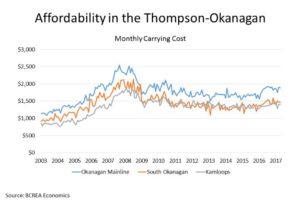 Because of these factors, the average residential price is expected to continue an upward trend this year across the Thompson-Okanagan region, with apartments in the Okanagan Mainline area and townhouses in both the South Okanagan and Kamloops experiencing most significant gains. The relative affordability of the region continues to underpin demand. However, while the typical monthly carrying cost is still below the highs recorded in 2008, relative affordability has eroded over the last 24 months.
Because of these factors, the average residential price is expected to continue an upward trend this year across the Thompson-Okanagan region, with apartments in the Okanagan Mainline area and townhouses in both the South Okanagan and Kamloops experiencing most significant gains. The relative affordability of the region continues to underpin demand. However, while the typical monthly carrying cost is still below the highs recorded in 2008, relative affordability has eroded over the last 24 months.
Source: BCREA
Jun 21, 2017 | Real Estate 101
 When you suffer damage to, (or the loss of ), your home or its contents, you expect your insurance company to help you out. And, most do a good job of doing just that.
When you suffer damage to, (or the loss of ), your home or its contents, you expect your insurance company to help you out. And, most do a good job of doing just that.
Still, it’s a good idea to review your policy with your insurance advisor and find out what’s covered and what isn’t. You don’t want to discover that your policy will not cover the cost of repairing the damage caused by a flood in your laundry room.
Pay particular attention to coverage in the case of water damage. Some insurance policies don’t cover floods and sewer backup unless an additional rider is purchased.
Also, check liability limits. Ask your advisor to recommend an appropriate level. Finally, make sure you know exactly how much your home is insured for. Are you covered for the full replacement cost? Are you comfortable with that coverage or the actual cash value?
Having the right insurance gives you peace-of-mind and is an important part of enjoying your home.
Keep in mind that experts advise you to review your insurance with your advisor. Ask lots of questions. Make sure you understand your coverage fully.
By the way, if you’re looking for an insurance advisor, I’m well-connected in the local “home” industry. I may be able to give you a couple of names of good, reputable professionals.
Email Beth for more information
Jun 19, 2017 | Real Estate 101
 You probably know there’s more to selling a home than putting up a For Sale sign. But, if you don’t understand the process in detail, you might feel intimidated and stressed when it comes time to put your property on the market.
You probably know there’s more to selling a home than putting up a For Sale sign. But, if you don’t understand the process in detail, you might feel intimidated and stressed when it comes time to put your property on the market.
Fortunately, the home selling process isn’t that difficult to understand. There are basically six steps.
Step one is selecting the right REALTOR®. You need a knowledgeable, trusted expert who can guide you through the process, take care of all the details, and help sell your home quickly and for the best price.
Step two is preparation. You need to ensure your home is clean and uncluttered. It’s also important that you take care of any needed repairs, even minor ones like wall dents.
Step three is the listing price. You need to select a listing price at or near the fair market value of your property.
Step four is promotion. How will buyers find out about your property? An effective promotion plan is critical.
Step five is dealing with offers. Ideally, you’ll get several. But the best offer is not necessarily the highest one. An offer can fall through for many reasons, so dealing effectively with offers is, perhaps, the most important part of the home selling process.
Step six is the transaction. Once the sale is made, you want to know that you have the right professionals in place – your lawyer, mover, etc. – to make sure all the after-sale details are taken care of properly.
Want more ideas for making sure the home selling process goes smoothly for you? Contact me today.
Email Beth for more information
Jun 14, 2017 | Real Estate 101
 There’s a famous saying in the real estate business: “Location, location, location”. It simply means that where your home is located — the neighbourhood — is just as important to potential buyers as the features of the property itself.
There’s a famous saying in the real estate business: “Location, location, location”. It simply means that where your home is located — the neighbourhood — is just as important to potential buyers as the features of the property itself.
Sellers often make the mistake of creating a long list of home features while ignoring neighbourhood features. They tout the spacious kitchen, and the newly renovated bathrooms, but say little about the area.
So, when you’re ready to sell your home, sit down and create two lists: home features and neighbourhood features. Buyers want to know both.
On the neighbourhood features list, include:
- Location of schools and daycare centres.
- Major retailers and shopping centres.
- Proximity to major commuting routes.
- Theatres, night clubs and other entertainment.
- Rinks, gyms and other sporting facilities.
- Green space, walking trails, ponds.
When buyers have their eyes on two properties which are comparable in features, the neighbourhood is often the deciding factor.
Jun 12, 2017 | Homeowners
 Over the summer, the demand for water to maintain lawns and gardens can stress supply and reservoir systems, and increase costs for taxpayers and users. Bearing in mind watering restrictions that may apply in your municipality, consider the following ways to minimize your overall water consumption during extended periods without rainfall.
Over the summer, the demand for water to maintain lawns and gardens can stress supply and reservoir systems, and increase costs for taxpayers and users. Bearing in mind watering restrictions that may apply in your municipality, consider the following ways to minimize your overall water consumption during extended periods without rainfall.
First, check your hose or irrigation equipment for leaks, and position sprinklers so that you’re not wasting water on hard surfaces such as driveways and patios.
To apply water more directly to the soil and reduce evaporation, use a soaker hose placed on the ground at the base of plants.
Whenever possible, water slowly to avoid run-off, ideally in early morning – before the heat of the summer sun can cause evaporation.
For conservation, direct rainwater from your roof gutters and downspouts to one or more rain barrels, but be sure to use insect screening to prevent mosquitoes from breeding.
 The Thompson-Okanagan region is served by the Okanagan Mainline and South Okanagan Real Estate Boards, as well as the Kamloops & District Real Estate Association. Strong economic conditions in the region are consistent with overall provincial economic performance. The urban centres of Kamloops and Kelowna have increasingly diversified economies that support population growth, rising employment levels and new construction activity.
The Thompson-Okanagan region is served by the Okanagan Mainline and South Okanagan Real Estate Boards, as well as the Kamloops & District Real Estate Association. Strong economic conditions in the region are consistent with overall provincial economic performance. The urban centres of Kamloops and Kelowna have increasingly diversified economies that support population growth, rising employment levels and new construction activity. Employment growth in business services, construction and tourism has been particularly robust. While a favourable exchange rate benefits BC exporters, it is also causing an increase in tourism-related activities from international visitors and from Canadians choosing to spend their vacation dollars at home.
Employment growth in business services, construction and tourism has been particularly robust. While a favourable exchange rate benefits BC exporters, it is also causing an increase in tourism-related activities from international visitors and from Canadians choosing to spend their vacation dollars at home. Net migration to the region has returned as a key population growth component after a significant decline in the post-recession period. Both migration from other provinces and from within British Columbia are bolstering the region’s population and adding to housing demand. While the proportion of home-buyers in the Okanagan Mainline Real Estate Board area originating from Alberta has declined since 2014, there has been an offsetting increase in activity origination from Metro Vancouver. The Thompson-Okanagan region’s relative affordability, employment opportunities and retirement lifestyle are significant drivers of migration and overall population growth.
Net migration to the region has returned as a key population growth component after a significant decline in the post-recession period. Both migration from other provinces and from within British Columbia are bolstering the region’s population and adding to housing demand. While the proportion of home-buyers in the Okanagan Mainline Real Estate Board area originating from Alberta has declined since 2014, there has been an offsetting increase in activity origination from Metro Vancouver. The Thompson-Okanagan region’s relative affordability, employment opportunities and retirement lifestyle are significant drivers of migration and overall population growth. Market conditions in the region have continued to tighten this year. Strong consumer demand has drawn down the inventory of homes for sale and created more intense competition among home-buyers. Total active listings on the market in May were down nearly 28% in Kamloops, and 16-19% in the Okanagan boards, compared to the same time last year.
Market conditions in the region have continued to tighten this year. Strong consumer demand has drawn down the inventory of homes for sale and created more intense competition among home-buyers. Total active listings on the market in May were down nearly 28% in Kamloops, and 16-19% in the Okanagan boards, compared to the same time last year. Because of these factors, the average residential price is expected to continue an upward trend this year across the Thompson-Okanagan region, with apartments in the Okanagan Mainline area and townhouses in both the South Okanagan and Kamloops experiencing most significant gains. The relative affordability of the region continues to underpin demand. However, while the typical monthly carrying cost is still below the highs recorded in 2008, relative affordability has eroded over the last 24 months.
Because of these factors, the average residential price is expected to continue an upward trend this year across the Thompson-Okanagan region, with apartments in the Okanagan Mainline area and townhouses in both the South Okanagan and Kamloops experiencing most significant gains. The relative affordability of the region continues to underpin demand. However, while the typical monthly carrying cost is still below the highs recorded in 2008, relative affordability has eroded over the last 24 months.
 When you suffer damage to, (or the loss of ), your home or its contents, you expect your insurance company to help you out. And, most do a good job of doing just that.
When you suffer damage to, (or the loss of ), your home or its contents, you expect your insurance company to help you out. And, most do a good job of doing just that. You probably know there’s more to selling a home than putting up a For Sale sign. But, if you don’t understand the process in detail, you might feel intimidated and stressed when it comes time to put your property on the market.
You probably know there’s more to selling a home than putting up a For Sale sign. But, if you don’t understand the process in detail, you might feel intimidated and stressed when it comes time to put your property on the market. There’s a famous saying in the real estate business: “Location, location, location”. It simply means that where your home is located — the neighbourhood — is just as important to potential buyers as the features of the property itself.
There’s a famous saying in the real estate business: “Location, location, location”. It simply means that where your home is located — the neighbourhood — is just as important to potential buyers as the features of the property itself. Over the summer, the demand for water to maintain lawns and gardens can stress supply and reservoir systems, and increase costs for taxpayers and users. Bearing in mind watering restrictions that may apply in your municipality, consider the following ways to minimize your overall water consumption during extended periods without rainfall.
Over the summer, the demand for water to maintain lawns and gardens can stress supply and reservoir systems, and increase costs for taxpayers and users. Bearing in mind watering restrictions that may apply in your municipality, consider the following ways to minimize your overall water consumption during extended periods without rainfall.